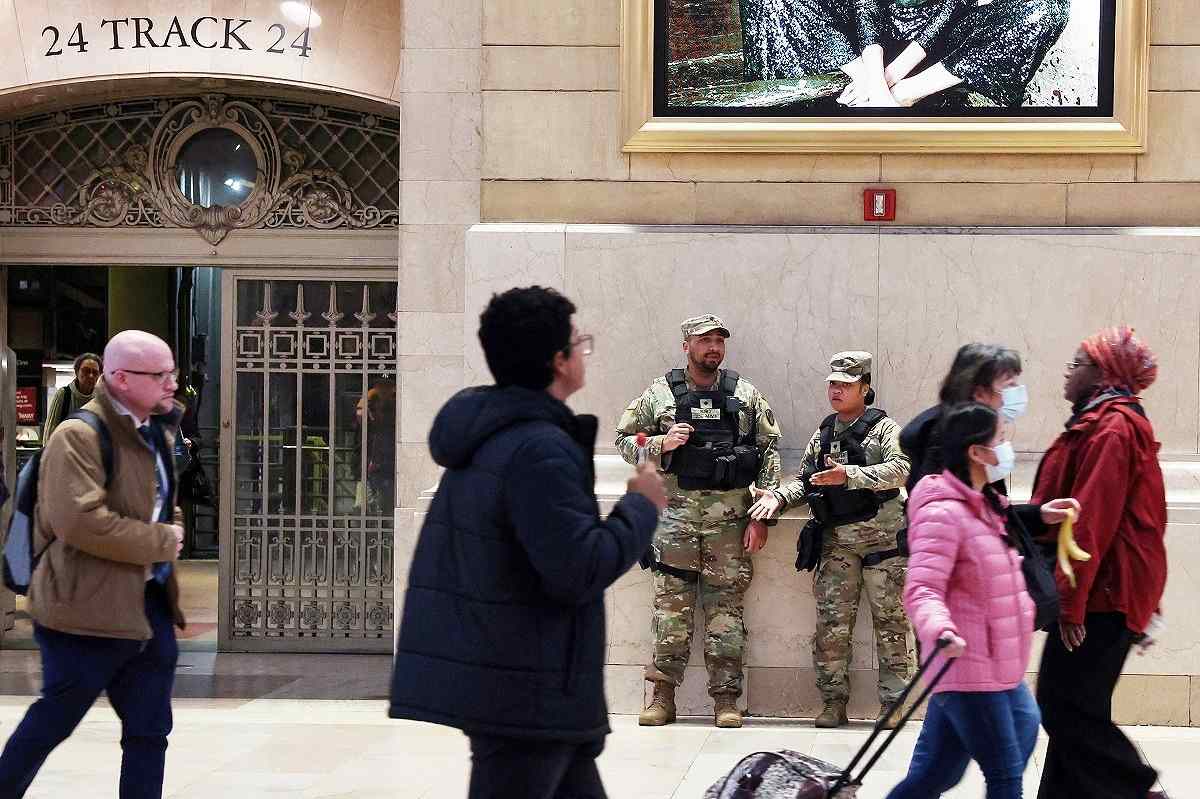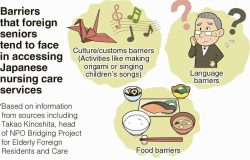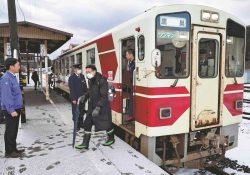
New York National Guard members stand guard inside Grand Central Station in New York on March 26.
8:00 JST, May 6, 2024
The following is an installment of the “Letter from New York” column by Jacob Margolies, The Yomiuri Shimbun’s General Counsel for America. Having practiced law for over three decades in New York, he explores a variety of topics — cultural, economic and political — in and around the Big Apple, and examines issues that the United States, Japan and the world at large are facing.
On March 25, a New York City police officer, Jonathan Diller, was shot and killed while going to check on the occupants of an illegally parked car. It was the first killing of a New York police officer in over two years and followed a series of crimes on the city’s subway system that had been heavily covered by the press and on social media.
Turning Diller’s death into a political event, former President Donald Trump attended the officer’s wake and spoke to the press outside the funeral home. “We have to get back to law and order,” Trump said.

Earlier in the week, after attending a legal hearing in New York in which he was the defendant, Trump said: “We have violent criminals that are murdering people, killing people. We have drug dealers all over the place, and they go free, and they can do whatever they want.”
Trump’s language about murderers and drug dealers may seem feverish, but being the political party that is tough on crime — at least rhetorically — has been a fundamental and successful element of Republican political campaigns for over 50 years.
In the 1968 U.S presidential election, Richard Nixon spoke repeatedly of restoring “law and order” and representing the “silent majority.” It was a message that struck a chord with many voters shaken by massive demonstrations protesting the Vietnam War and riots after the assassination of civil rights leader Martin Luther King Jr.
In 1981, in a heavily covered speech, then President Ronald Reagan, speaking to a convention of police chiefs and reprising language from his campaign, said: “There has been a breakdown in the criminal justice system in America … career criminals … are robbing, raping and beating with impunity, quite literally getting away with murder. The people are sickened and outraged.”
During the 1988 presidential election, George H.W. Bush’s accusations that his Democratic opponent, Massachusetts Gov. Michael Dukakis, was lenient with criminals were a centerpiece of his successful candidacy. Republican-funded TV commercials featured the case of Willie Horton who, after being released for a weekend under a state furlough program, failed to return and then committed assault, robbery and rape before being recaptured. Bush’s campaign manager, Lee Atwater, said, “If I can make Willie Horton a household name, we’ll win the election.”
Crime in most major American cities declined in 2023, but violent crime rates remain significantly higher than they were in 2019, before the start of COVID and the social unrest that occurred in many cities after the 2020 murder of George Floyd by a Minneapolis police officer.
According to experts, the reported crime least subject to statistical manipulation is murder. In New York, after decreasing over a period of nearly 30 years, the number of murders increased from 319 in 2019 to 468 the following year. Last year, the number declined to 391, but that is substantially more than any year from 2013 to the pandemic.
Whatever the most recent statistics on crime may show, perceptions of public safety in New York have changed dramatically since the pandemic.
In a 2023 survey by the Citizens Budget Commission of 6,600 people, only 51% of New Yorkers said they felt safe walking in their neighborhood at night, a dramatic drop from the 71% figure when residents were asked the same question in 2017.
Subway riders’ sense of safety declined even more sharply. In 2023, less than half of all New Yorkers reported feeling safe on the subway. Fewer than three in 10 New Yorkers rated their quality of life as excellent or good, a decline of 20 percentage points since 2017.
New Yorkers’ general unhappiness can be understood as an outgrowth of the pandemic and social dislocations connected to it.
From mid-March to mid-June of 2020, the city recorded almost 23,000 deaths from COVID-19 and had a mortality rate from the virus that was higher than that of all 50 states and every one of the 3,140 counties in the United States.
Besides crime, the city has still not fully recovered from declines in other areas of daily life. In 2022, math scores in the United States for 9-year-old children fell by the largest margin in more than 30 years, no doubt because of extended school closures during the pandemic. In New York State, student test score declines were greater than the national average.
Central business districts in the city remain quiet. The office vacancy rate in Manhattan in the first quarter of 2024 was 24.3%, more than double the rate in 2019, and subway ridership is still only 70% of what it was before the pandemic.
It is on New York’s subway system that concerns about crime and disorder are particularly acute. Daily riders are captive to the conditions they encounter on station platforms and train cars, and the subway is so central to the life of the city that it plays an outsize role in the fantasies and nightmares of its residents.
In real life, if one is paying attention, a subway rider can witness the pageant of humanity. Riding the F train one day in April, I encountered Mexican musicians, one on guitar and the other on accordion, playing norteno music. A few minutes later, I heard a beggar’s exquisitely crafted tale of hardship. On my ride home that day, a middle-aged woman preacher from the Caribbean loudly announced that I and my fellow riders were all bound for damnation. The person across the aisle from me reading a novel by Balzac never looked up from his book.
There are also more disturbing subway encounters that are not infrequent. Angry outbursts from extremely agitated mentally ill men, unbathed homeless people stinking up the subway car so badly that it becomes unbearable and strangers getting into an argument over some perceived slight. It is a sense of disorder, rather than danger, that makes riding the subways a dispiriting experience for many people.
Violent crime on the subway, however, is extremely rare. By some measures, a serious crime happens once per one million rides, but felonies underground increased during the first three years of the pandemic, before declining by 3% in 2023, according to The New York Times.
This year a series of highly publicized violent random attacks terrified riders. Some of these incidents were recorded on riders’ cell phones and have been watched millions of times on social media.
One heavily viewed video of a March incident shows a fight between two riders in a crowded subway car that ended with one person shooting the other as passengers huddled on the floor and under seats. This came only two weeks after a train conductor was slashed as he stuck his head out of the train at a Brooklyn station. Following that assault, transit workers were accused of carrying out a brief work slowdown to protest the lack of security. On March 25 — the same day Officer Diller lost his life in the line of duty — a person waiting on a platform was killed when he was pushed by a stranger onto the tracks in front of an oncoming train.
In response to the perception of a crisis, the city deployed 1,000 additional police to the system in February. In March, New York State Gov. Kathy Hochul assigned an additional 1,000 National Guard and State Police to patrol the subways.
At an April press conference, Mayor Eric Adams and police officials boasted that the increased policing had resulted in subway crime declining by 24% in March 2024 compared with the same period in 2023, with 166 felony crimes reported at subway stations citywide compared with 217 in March 2023.
Whether it is rising or falling, the strong emotions crime engenders will inevitably be exploited as a political issue. Less than a month before the U.S. presidential election, a trial that focuses on an alleged crime that occurred on the city subways will take place in New York, and it will not be surprising if Trump and surrogates for both Trump and President Joe Biden weigh in on the case during the final weeks of the campaign.
On Oct. 8, Daniel Penny, a former U.S. marine, will go on trial on manslaughter charges for choking a homeless man to death on a subway car.
According to witnesses, the man who was killed, Jordan Neely, was yelling and harassing passengers on the train when Penny, who has pleaded innocent, intervened. Neely was black and Penny is white.
The trial will raise questions about policing, mental illness, homeless outreach, vigilantism, racism and crime — and it is certain that consideration of the case will be inflamed by histrionics on social media, sensational news coverage and political demagoguery.
"JN Specialities" POPULAR ARTICLE
-

The Japan News / Weekly Edition (12/12-12/18)
-

English-language Kabuki, Kyogen Entertain Audiences in Tokyo; Portland State University Professor Emeritus, Graduates Perform
-

Noodle Dining Shunsai / Rich Oyster Ramen to Savor at Odasaga; Experienced 68-year-old Owner Creates Numerous Ramen Varieties
-

The Japan News / Weekly Edition (12/5-12/11)
-

People Keep Loved Ones’ Ashes Close in Special Jewelry, Small Urns as Unique Way to Memorialize Them
JN ACCESS RANKING
-

Keidanren Chairman Yoshinobu Tsutsui Visits Kashiwazaki-Kariwa Nuclear Power Plant; Inspects New Emergency Safety System
-

Imports of Rare Earths from China Facing Delays, May Be Caused by Deterioration of Japan-China Relations
-

Japan Exports Rise in October as Slump in U.S. Sales Eases
-

Japan Pulls out of Vietnam Nuclear Project, Complicating Hanoi’s Power Plans
-

Govt Aims to Expand NISA Program Lineup, Abolish Age Restriction
























